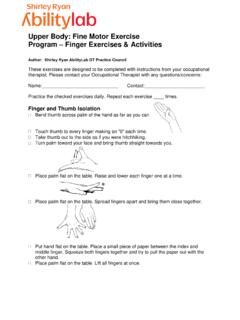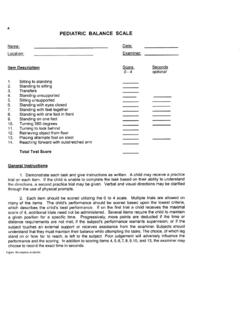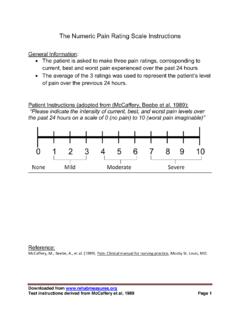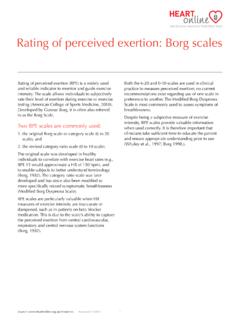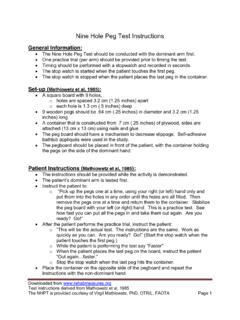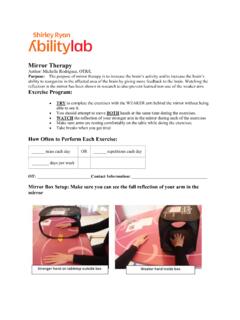Transcription of AXIS I: CONCENTRATION (circle only one, i.e., the most ...
1 NAME: _____ ID#: _____ DATE: ___/___/___ PERIOD: _____ BRIEF COGNITIVE RATING SCALE (BCRS)1,2 INFORMANT: _____ RELATIONSHIP OF INFORMANT: _____ AXIS I: CONCENTRATION (circle only one, , the most appropriate level) 1 No objective or subjective evidence of deficit in CONCENTRATION . 2 Subjective decrement in CONCENTRATION ability. 3 Minor signs of poor CONCENTRATION ( , subtraction of serial 7s from 100). 4 Definite CONCENTRATION deficit for persons of their background ( , marked deficit on serial 7s, frequent deficit in subtraction of serial 4s from 40). 5 Marked CONCENTRATION deficit ( , giving months backwards or serial 2s from 20).
2 6 Forgets the CONCENTRATION task. Frequently begins to count forward when asked o count backwards from 10 by 1s. 7 Marked difficulty counting forward to 10 by 1s. AXIS II: RECENT MEMORY (circle only one, , the most appropriate level) 1 No objective or subjective evidence of deficit in recent memory. 2 Subjective impairment only ( , forgetting names more than formerly). 3 Deficit in recall of specific events evident upon detailed questioning, ( about recent meals, current reading, recent appointments, etc). No deficit in the recall of major recent events. 4 Cannot recall major events of previous weekend or week. Scanty knowledge (not detailed) of current events, favorite TV shows, etc.
3 May not know telephone number and/or telephone area code and/or postal (zip) code. 5 Unsure of weather, and/or may not know current president and/or current address. 6 Occasional knowledge of some recent events. Little or no idea of current address, weather, etc. Given the current president's first name, may recall their last name. 7 No knowledge of any recent events. AXIS III: PAST MEMORY (circle only one, , the most appropriate level) 1 No subjective or objective impairment in past memory. 2 Subjective impairment only. Can recall two or more primary school teachers. 3 Some gaps in past memory upon detailed questioning. Able to recall at least one childhood teacher and/or one childhood friend.
4 4 Clear-cut deficit. The spouse recalls more of the patient's past than the patient. Cannot recall childhood friends and/or teachers but knows the names of schools attended. Confuses chronology in reciting personal history. 5 Major past events sometimes not recalled ( , names of schools attended). Characteristically, at this stage patients recall some schools attended, but not others. 6 Some residual memory of past ( , may recall country of birth or former occupation, may or may not recall mother's name, may or may not recall father's name). Generally, patients do not recall any of the schools which they attended. 7 No memory of past (cannot recall country, state, or town of origin, cannot recall names of parents, etc.)
5 AXIS IV: ORIENTATION (circle only one, , the most appropriate level) 1 No deficit in memory for time, place, identity of self or others. 2 Subjective impairment only. Knows time to the nearest hour. Knows location. 3 Any mistake in time of two hours or more, day of the week of 1 day or more, date of 3 days or more. 4 Mistakes day of the month by 10 days or more, and/or confuses month of the year by 1 month or more. 5 Unsure of month and/or year and/or season, unsure of locale. 6 No idea of date. Identifies spouse but may not recall name. Knows own name. 7 Cannot identify spouse. May be unsure of personal identity. AXIS V: FUNCTIONING AND SELF-CARE a (circle only one, , the most appropriate level) 1 No difficulty, either subjectively or objectively.
6 2 Complains of forgetting location of objects. Subjective work difficulties. 3 Decreased job functioning evident to co-workers. Difficulty in traveling to new locations. Decreased organizational capacity .* 4 Decreased ability to perform complex tasks, , planning dinner for guests, handling personal finances (such as forgetting to pay bills), difficulty marketing, etc.* 5 Requires assistance in choosing proper clothing to wear for the day, season, or occasion, patient may wear the same clothing repeatedly, unless supervised.* 6 Requires assistance in putting on clothing, and/or bathing, and/or toileting, and/or feeding.
7 * 7 Requires constant assistance in all activities of daily life.* *Scored primarily on the basis of information obtained from a knowledgeable informant and/or caregiver. aThe Functional Assessment Staging (FAST) scale can be utilized in lieu of Axis V for more precise staging. 1 Adapted from Reisberg, B. and Ferris, , Brief Cognitive Rating Scale (BCRS). Psychopharmacology Bulletin, 1988; 24:629-636. 2 Copyright 1984 Barry Reisberg, All rights reserved. BRIEF COGNITIVE RATING SCALE (BCRS) INSTRUCTIONS Each axis of the Brief Cognitive Rating Scale is scored independently. Each axis is designed to be optimally concordant with the other axes and with the numerically corresponding Global Deterioration Scale stage.
8 Consequently, each axis of the BCRS conveys important staging related information. For clinical purposes scores can be reported conveniently as consecutive axis scores, , A6,5,6,4,5". This reporting methodology indicates relative capacity in each axis modality, , CONCENTRATION , recent memory, etc. For therapeutic trials the axes can be added and total scores for the five axes can be utilized. For staging, the Global Deterioration Scale stage is very closely equivalent to the average score of the BCRS axes. Ideally, for staging purposes, the BCRS can be used as a semistructured procedure for guiding final GDS stage assignments.
9



